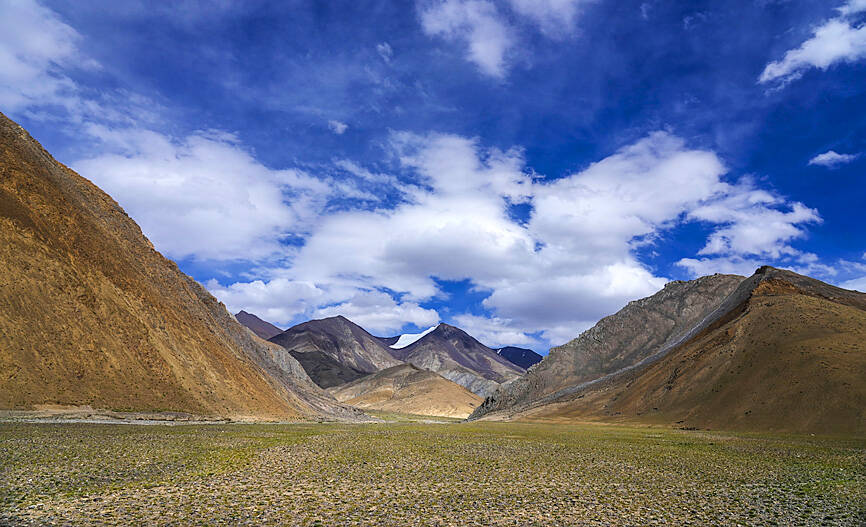Indian Minister of Defence Rajnath Singh yesterday accused China of trying to “unilaterally change the status quo” on their disputed Himalayan border last week when clashes left troops on both sides injured.
Beijing said the situation was now calm and called on India to help China “together uphold the peace and tranquility of the ... border region.”
The incident is thought to be the most serious on the nuclear-armed Asian giants’ disputed frontier since 2020, when 20 Indian troops and four Chinese soldiers died in brawling.

Photo: AP
Singh confirmed in parliament that Indian and Chinese troops engaged in the fresh confrontation on Friday in the northeastern Indian state Arunachal Pradesh.
China and India fought a full-scale war in 1962 over control of Arunachal Pradesh, which Beijing claims in its entirety and considers part of Tibet.
“On 09 December 2022, [Chinese] PLA [People’s Liberation Army] troops attempted to unilaterally change the status quo by encroaching on the Line of Actual Control, in the Yangtze area of Tawang sector,” Singh said.
The face-off, which followed recent joint US-India military exercises near the border that angered Beijing, led to “injuries to soldiers on both sides,” he added.
“A scuffle ensued in this face-off. The Indian Army bravely prevented the PLA from encroaching on our territory, and forced them to withdraw to their posts. Some soldiers from both sides were injured in the skirmish,” he said.
A military source said that at least six Indian soldiers were injured.
In Beijing, Chinese Ministry of Foreign Affairs spokesman Wang Wenbin (汪文斌) said that he believed the situation was now calm, but gave no details of what happened or whether Chinese troops were injured.
“As far as we understand, the China-India border situation is stable overall,” Wang said, adding that the two sides “maintained unobstructed dialogue on the border issue through diplomatic and military channels.”
“It is hoped that the Indian side will advance in the same direction as China, earnestly implement the important consensus reached by both leaders, strictly abide by the spirit of the agreements and accords signed by both sides [and] together uphold the peace and tranquility of the China-India border region,” he said.
Singh said that local commanders from both sides held a flag meeting on Sunday and the incident was discussed.
Singh added that in the latest incident “none of our soldiers have died, nor has anyone been seriously injured.”
The military source said that there was another “face-off” between Indian and Chinese troops in the final week of last month in the Demchok region of Ladakh, to the northwest, near where the June 2020 incident took place.
It was unclear if there were any injuries resulting from that incident, which was the most serious since September 2020.
The army source said that there had been increased activity in Ladakh by the Chinese military, as well as a “possible” airspace violation by the Chinese air force in the same area.

OPTIMISTIC: A Philippine Air Force spokeswoman said the military believed the crew were safe and were hopeful that they and the jet would be recovered A Philippine Air Force FA-50 jet and its two-person crew are missing after flying in support of ground forces fighting communist rebels in the southern Mindanao region, a military official said yesterday. Philippine Air Force spokeswoman Colonel Consuelo Castillo said the jet was flying “over land” on the way to its target area when it went missing during a “tactical night operation in support of our ground troops.” While she declined to provide mission specifics, Philippine Army spokesman Colonel Louie Dema-ala confirmed that the missing FA-50 was part of a squadron sent “to provide air support” to troops fighting communist rebels in

ECONOMIC DISTORTION? The US commerce secretary’s remarks echoed Elon Musk’s arguments that spending by the government does not create value for the economy US Secretary of Commerce Howard Lutnick on Sunday said that government spending could be separated from GDP reports, in response to questions about whether the spending cuts pushed by Elon Musk’s Department of Government Efficiency could possibly cause an economic downturn. “You know that governments historically have messed with GDP,” Lutnick said on Fox News Channel’s Sunday Morning Futures. “They count government spending as part of GDP. So I’m going to separate those two and make it transparent.” Doing so could potentially complicate or distort a fundamental measure of the US economy’s health. Government spending is traditionally included in the GDP because

Two daughters of an Argentine mountaineer who died on an icy peak 40 years ago have retrieved his backpack from the spot — finding camera film inside that allowed them a glimpse of some of his final experiences. Guillermo Vieiro was 44 when he died in 1985 — as did his climbing partner — while descending Argentina’s Tupungato lava dome, one of the highest peaks in the Americas. Last year, his backpack was spotted on a slope by mountaineer Gabriela Cavallaro, who examined it and contacted Vieiro’s daughters Guadalupe, 40, and Azul, 44. Last month, the three set out with four other guides

Sri Lanka’s fragile economic recovery could be hampered by threatened trade union strikes over reduced benefits for government employees in this year’s budget, the IMF said yesterday. Sri Lankan President Anura Kumara Dissanayake’s maiden budget raised public sector salaries, but also made deep cuts to longstanding perks in a continuing effort to repair the island nation’s tattered finances. Sri Lanka’s main doctors’ union is considering a strike from today to protest against cuts to their allowances, while teachers are also considering stoppages. IMF senior mission chief for Sri Lanka Peter Breuer said the budget was the “last big push” for the country’s austerity